In a highly significant World Cup clash — one that treated viewers to a rematch of the 2019 Women’s World Cup Final — the USA and the Netherlands faced each other. This was a game that can be divided into two distinct halves.
Despite missing star forward Vivianne Miedema, the Netherlands showcased their strength and resilience, putting up a strong performance that nearly led to a victory against the defending champions, the USA. The match ended in a draw, demonstrating the competitive nature of both teams and the high level of football on display.
For the USWNT, their impressive World Cup winning streak, spanning 13 games, came to an end in this hard-fought encounter. This tactical analysis will look at the tactics deployed by both sides which played a pivotal part in determining how the match played out. We will analyse how the Netherlands excelled with distinction in the first half before the USA displayed their quality and champion mentality to come back in the second.
Lineups
USA (4-3-3, right to left): Alyssa Naeher (GK) — Crystal Dunn, Naomi Girma, Julie Ertz, Emily Fox — Lindsey Horan, Andi Sullivan, Savannah DeMelo — Sophia Smith, Alex Morgan, Trinity Rodman.

Netherlands (3-1-4-2, right to left): Daphne van Domselaar (GK) — Ajax player Sherida Spitse, Stefanie van der Gragt, Dominique Janssen — Manchester City‘s Jill Roord — Victoria Pelova, Jackie Groenen, Danielle van de Donk, Esmee Brugts — Everton player Katja Snoeijs, Lieke Martens.
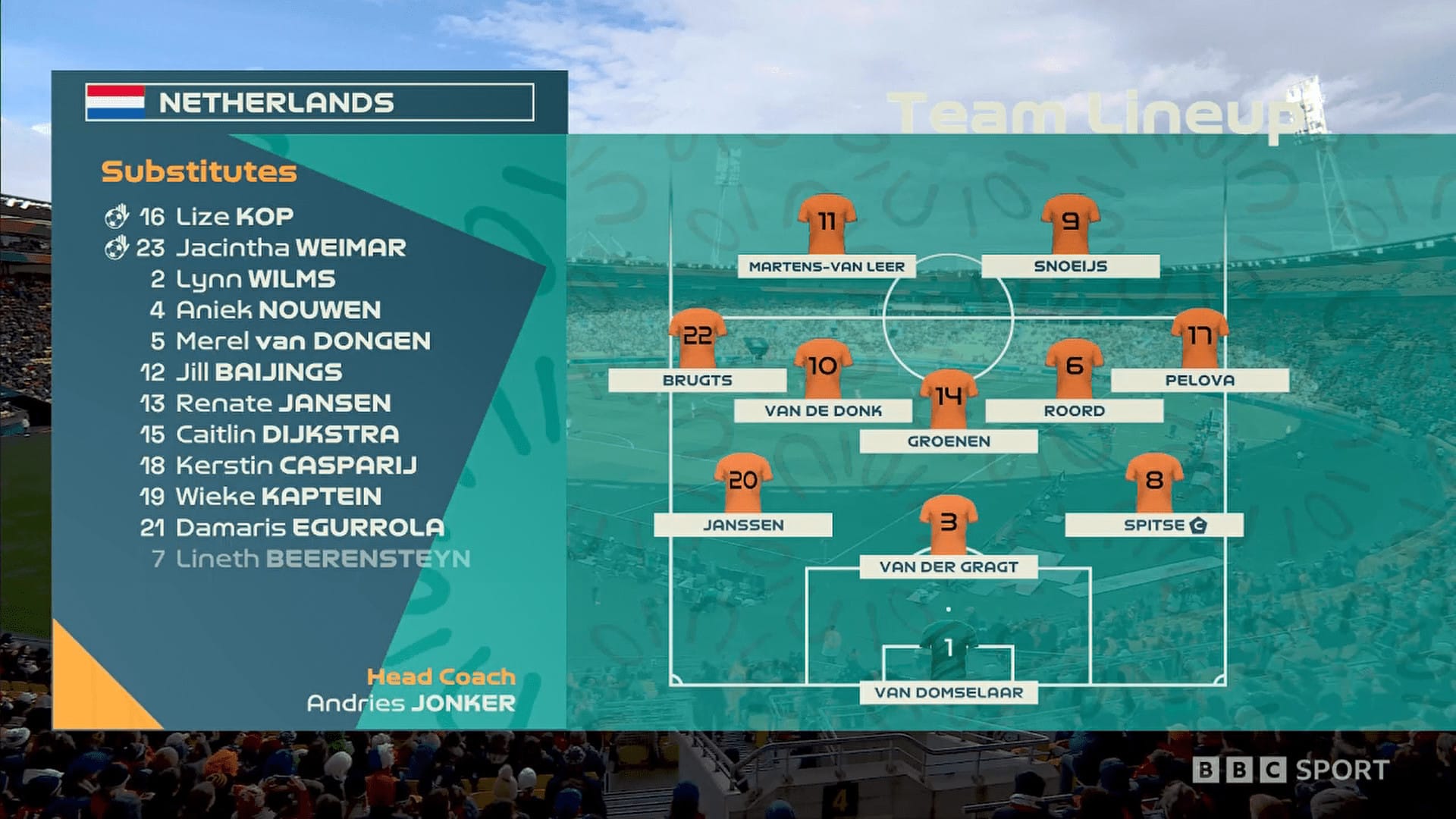
Netherlands — A solid first half
The Netherlands started the game with their well-known 3-5-2 structure and showed great enthusiasm with and without the ball from the very beginning. In the defensive phases, they played aggressively, applying high pressure to the USA, who usually build their game with a 4-1 or 4-2 base.

At the start of the match, the pressure applied by the Dutch women prevented the United States from building out along the ground. In our example from the fourth minute, the Dutch team pressed centrally with two players in the front line to direct the play out wide.

After the ‘keeper played the ball to the centre-back, the Dutch forward angled her run to cut off access to the middle of the park and force play wider.

Once the ball made its way out wide, the Netherlands pressed player-to-player there, using the sideline as an extra defender, limiting the amount of space the US had to play with and increasing their chances of winning the ball.
Throughout the game, this was quite effective and forced USA’s women to resort to playing long balls, whereas the Netherlands displayed remarkable determination in winning the majority of duels, generally.
The Netherlands demonstrated a distinguished performance in the first half of the match, exhibiting impressive teamwork, stability, and ball retention against one of the top teams in the game.
On the ball, Andries Jonker structured his team with a static 3-2 base, with a drop from the wing-backs to add an extra player when needed to counter USA’s 4-2-3-1 pressure.

The Dutch women displayed exceptional skill, passing accurately in tight areas and quickly rotating the ball from one side to the other after the Americans attempted to trap them.

The USA’s full-backs frequently stepped up to press the wing-backs; relying on penetration from the sides was not a practical solution for the Dutch team. Instead, they relied on something else from the depth. The Netherlands utilised a midfield box dynamically. This allowed them to create a 4v3 advantage against the USA’s midfield.
One of the Netherlands midfielders, Jill Roord, rose to the occasion, while the striker, Lieke Martens, dropped off to gain the positional advantage to receive the horizontal laser pass from the wide centre-back. Meanwhile, the other striker pins the backline.

This was repeated occasionally after luring the Americans from one side and switching the play to the other. This caused confusion for the USA’s defensive midfielder, sometimes resulting in the nearest centre-back needing to move up to confront.
When the American centre-back did not push to confront this positional and numerical superiority, this was dangerous and ultimately happened in the Netherlands’ goal. At this time, Lieke Martens received the ball from the central centre-back while USA’s No. 6 was in the midfield in a situation of 2v1 in an ample space.

Lieke Martens succeeded in receiving and rotating with one dynamic movement to find herself in an ample space against the backline before she passed the ball into the space to the right wing-back, who crossed it immediately.

After the rebound, the ball reached Jill Roord, who shot and scored the first goal brilliantly.

In general, during the game, especially in the first half, the Netherlands excelled in winning duels and counterpressing, showing their courage.

During the 27th minute, they had a dangerous chance. A long ball was sent, and Lieke Martens managed to win the second ball. Throughout the play, the wing-backs were providing width to quickly switch the ball.
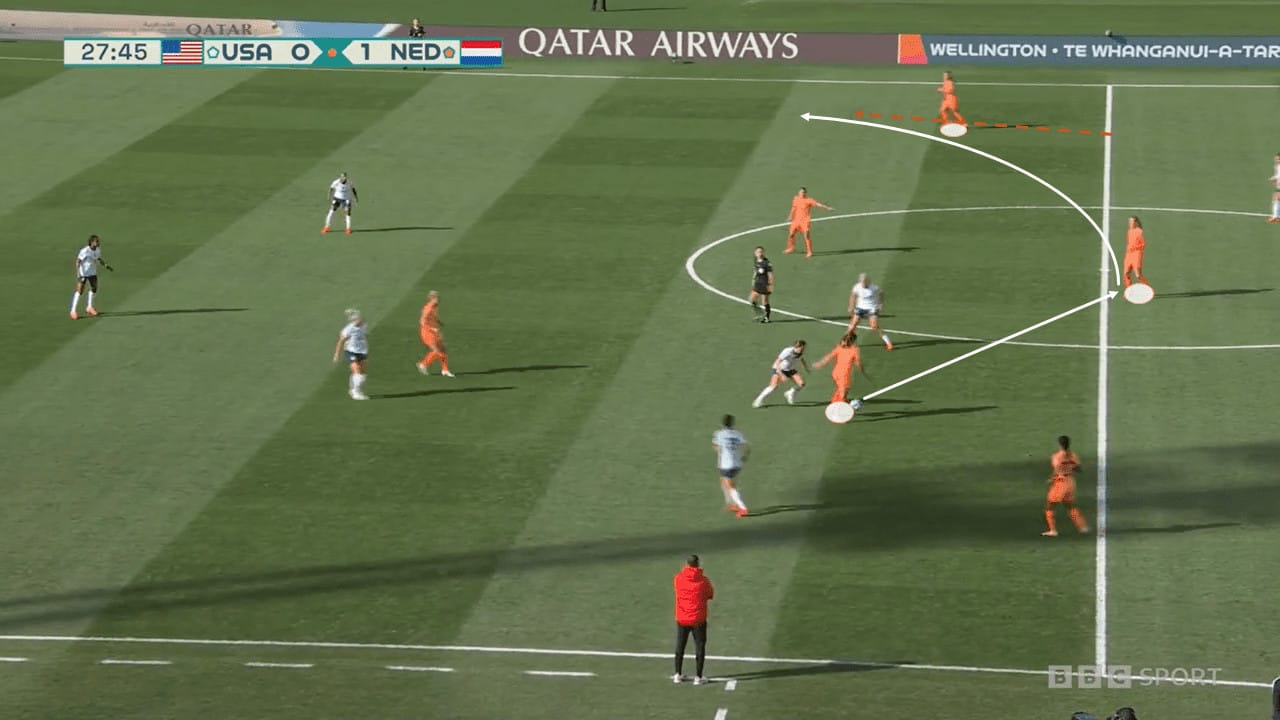
Here below, When the right wing-back gets the ball and moves forward towards the opponent’s final third, the left wing-back attacks the blindside of the box to receive the cross.
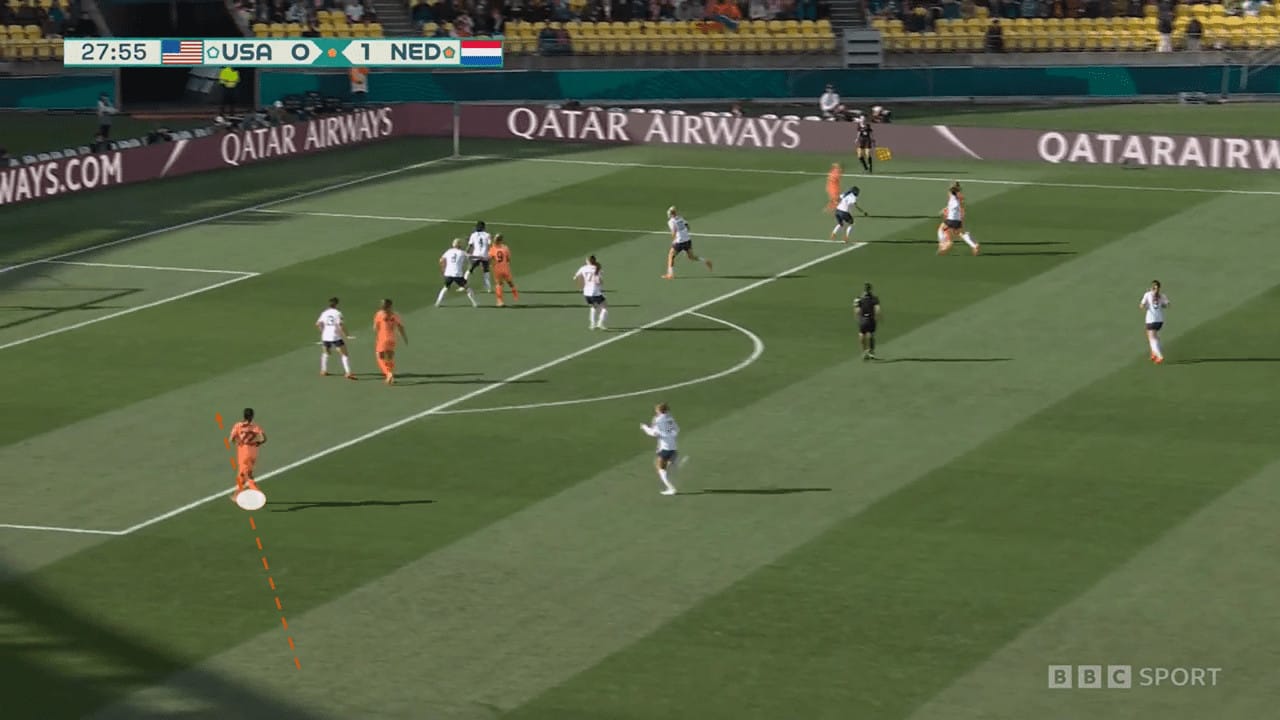
After the ball bounced back, Janssen, the left centre-back who had moved forward, took a shot that nearly led to the team’s second goal.
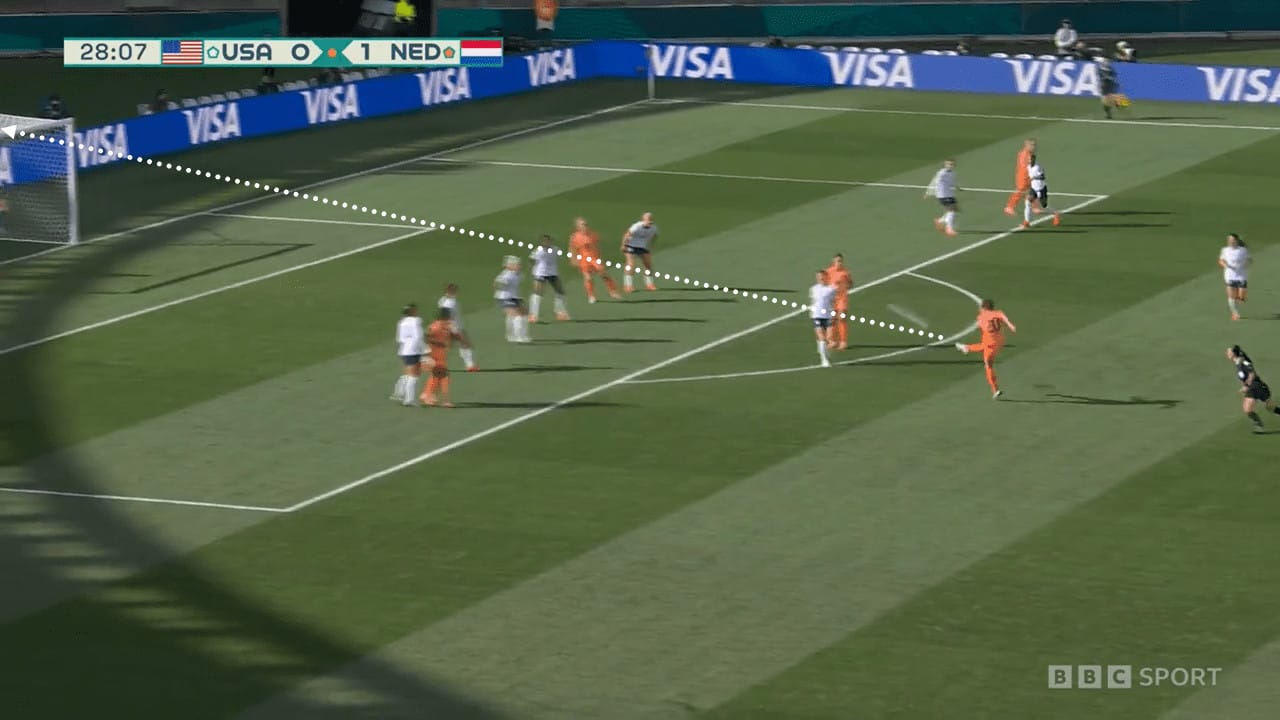
Unfortunately, after that, even with the Americans’ withdrawal. The Dutch team were not as threatening as they could have been, failing to pose a significant danger to the goal. Moreover, they missed opportunities to apply more pressure and score again.
USA — the recovery
The top-ranked team, led by coach Vlatko Andonovski, adopts a dynamic tactical approach. They typically start with a 4-3-3 shape but fluidly transform it into 2-3-5 or 2-2-4 using overlapping full-backs. The wingers play as inside forwards, making diagonal runs towards the half-spaces. Morgan drops deep to receive the ball, attracting a defender and creating openings in the opposition’s backline. At this point, one of the wingers exploits the space with a well-timed third-woman run, receiving the ball behind the defence.
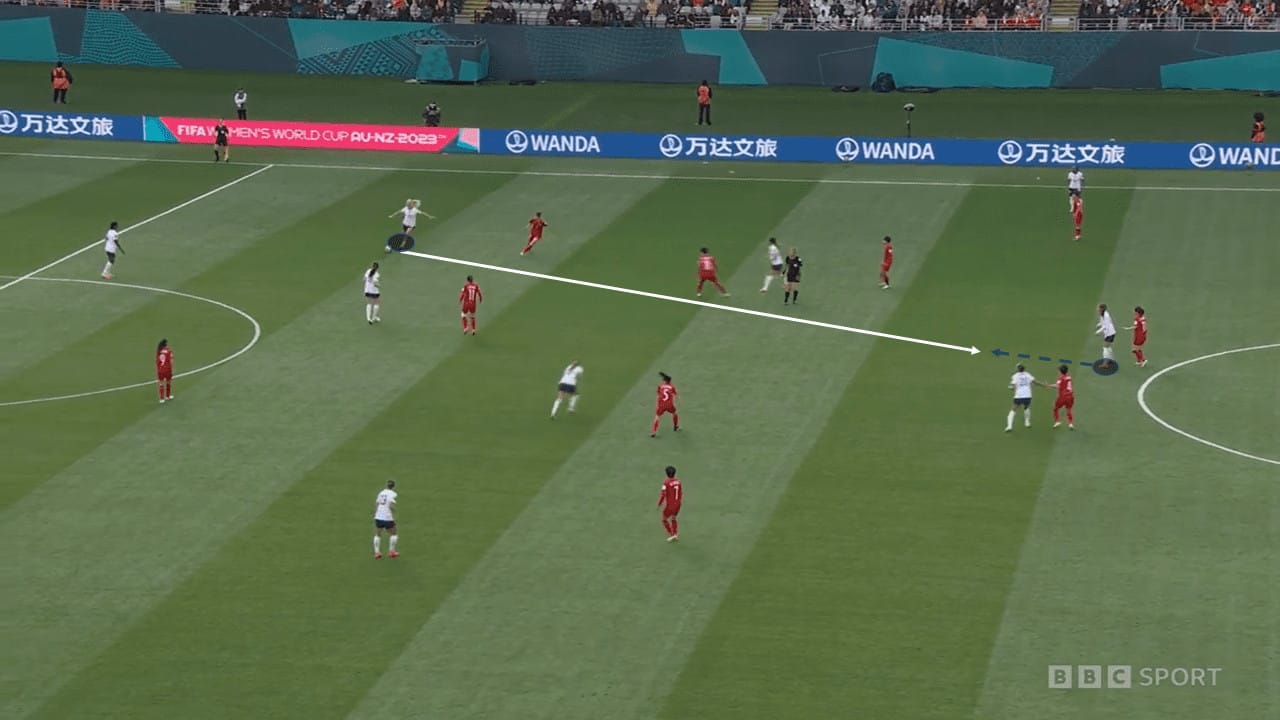
In the match against Vietnam, the team effectively executed this movement to score their first goal. As the defending champion, they showcased their prowess under Coach Vlatko Andonovski. It all started with a vertical pass to Morgan, who dropped deep to receive the ball. This clever move attracted a defender and created space for Sophia Smith to make a penetrating run behind the defence — a third-player combination.
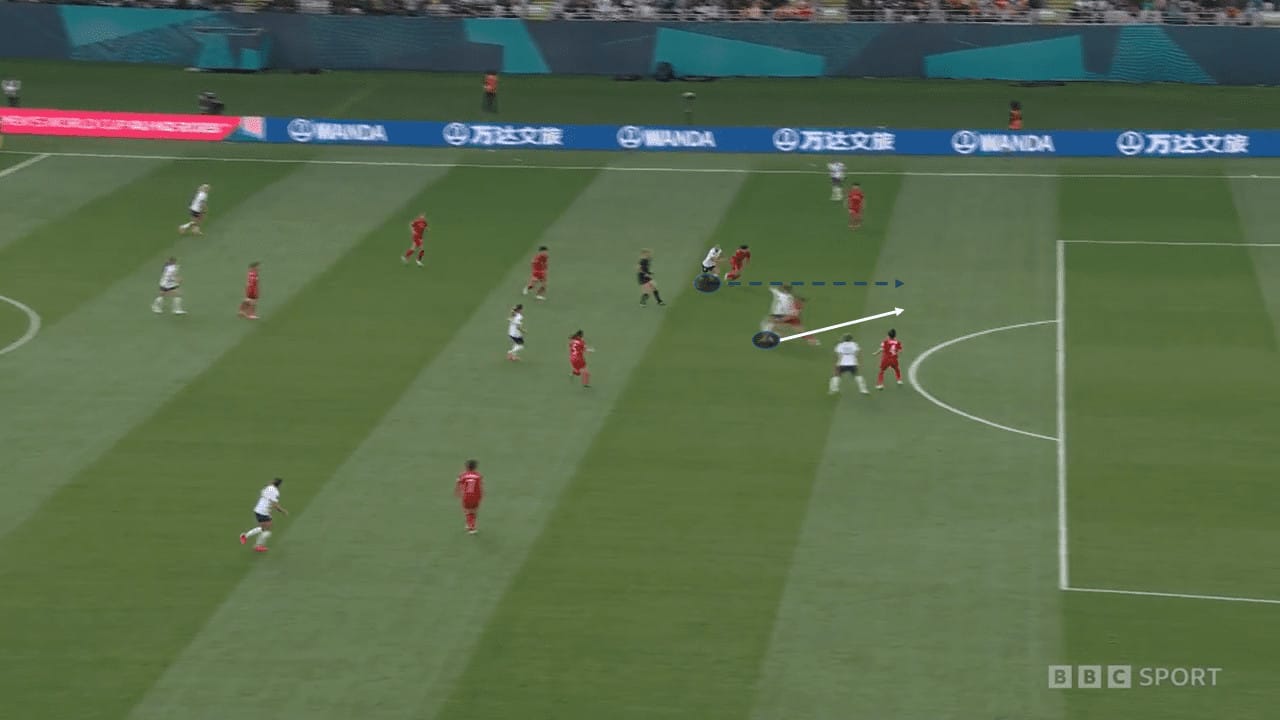
Taking full advantage of the situation, Smith found herself in a one-on-one situation with the goalkeeper and confidently netted the goal.
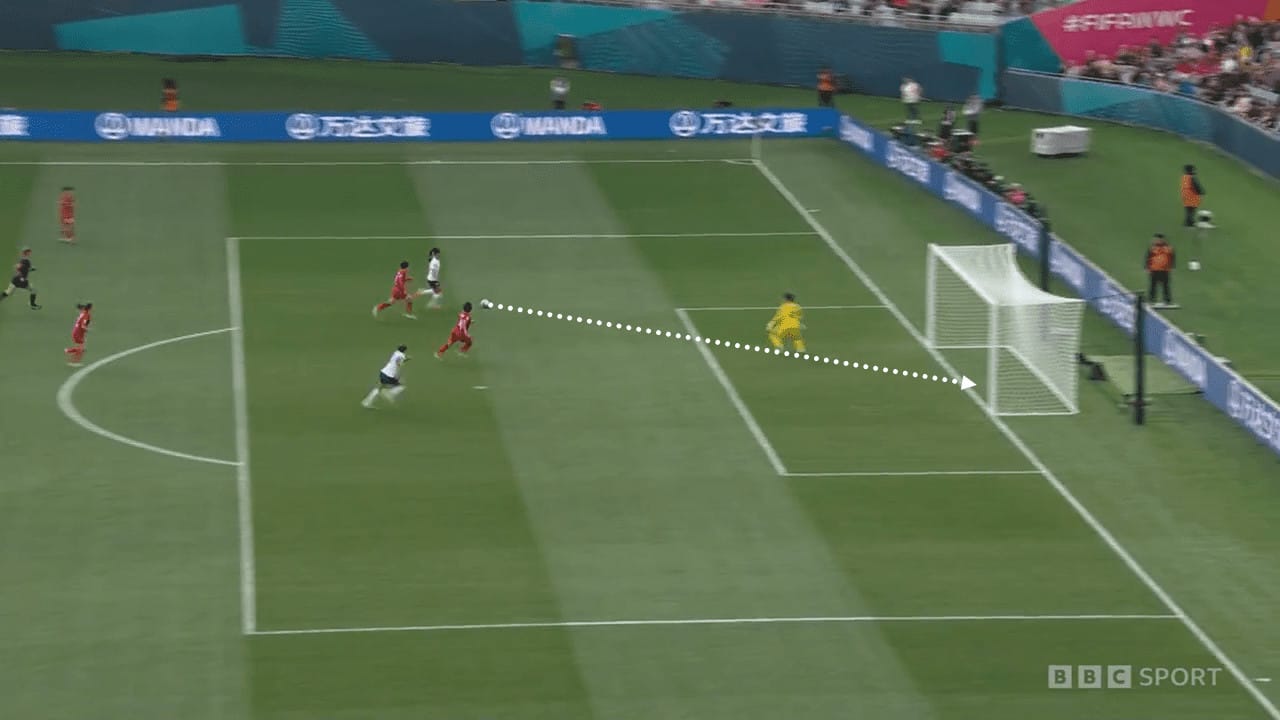
Following their 3-0 victory over Vietnam in the first game, Morgan expressed her concerns about the team’s performance and mentioned, “I think we saw a lot of glimpses of our potential, but I feel like we weren’t always clicking on the field,” also, “I feel like some of the plays we had were a little forced or rushed. So I think it’s having a little more patience, switching (play) a little more, having our movements a little more synchronised.”
Rushing. That’s precisely what they were doing with the ball the whole game against the Netherlands. As a result, they struggled to effectively speed up their attacks and create weaving patterns to break down the opposition’s defence. Additionally, the team lacked the composure to retain possession of the ball and control the match to their advantage.
Indeed, despite the rushed play and lack of control in the first half of the match against the Dutch, there were positive glimpses in the second half, particularly during counterattacks. The team’s wingers positioning inside were important, making them a constant threat during the transitions.
In the described scene, after the Netherlands switched play from the left to the right side, Sophia Smith and Lindsey Horan demonstrated quick and effective pressing on the ball carrier, resulting in Horan successfully regaining possession. This rapid turnover initiated a swift counterattack against an unorganised defence. The Americans attacked the space in different ways thanks to positioning the reverse wing inside.
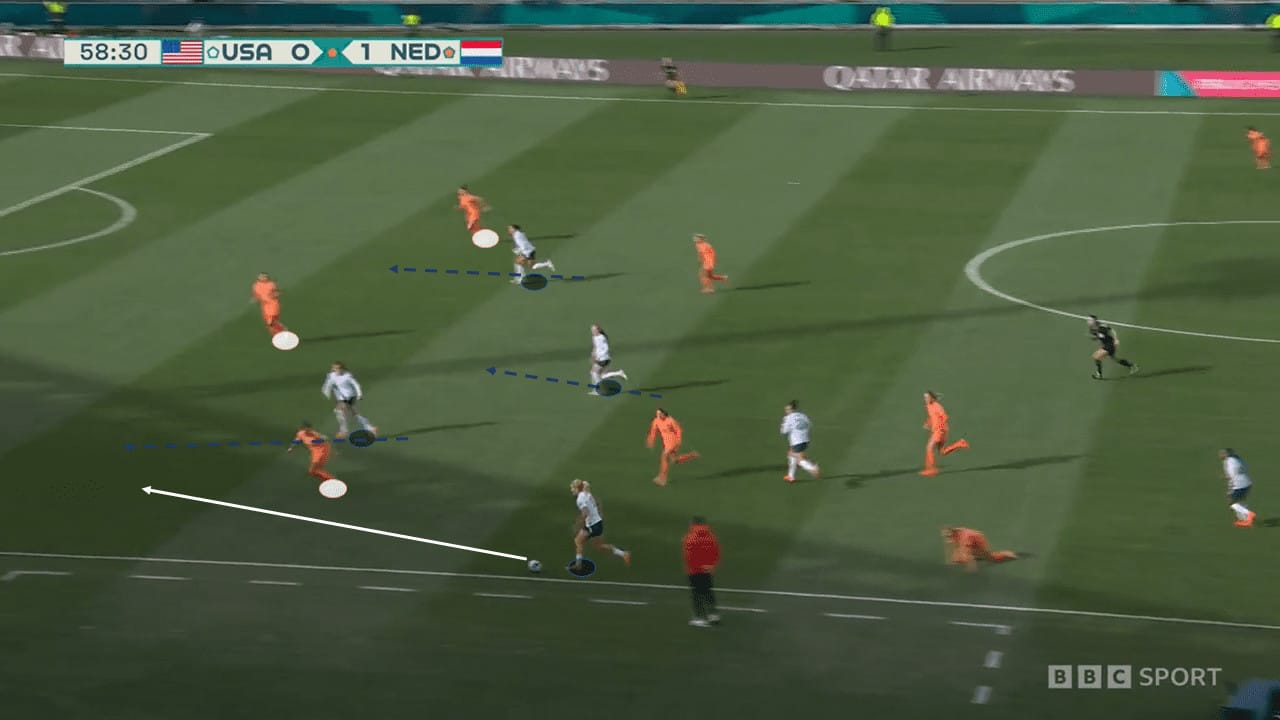
Alex Morgan received the ball in behind on the flank as play moves on from here thanks to her intelligent run and the passer’s well-executed ball, progressed along the wing and attempted a cross into the box. However, despite having a numerical parity of 2v 2, the cross was slightly higher than intended and missed its target.
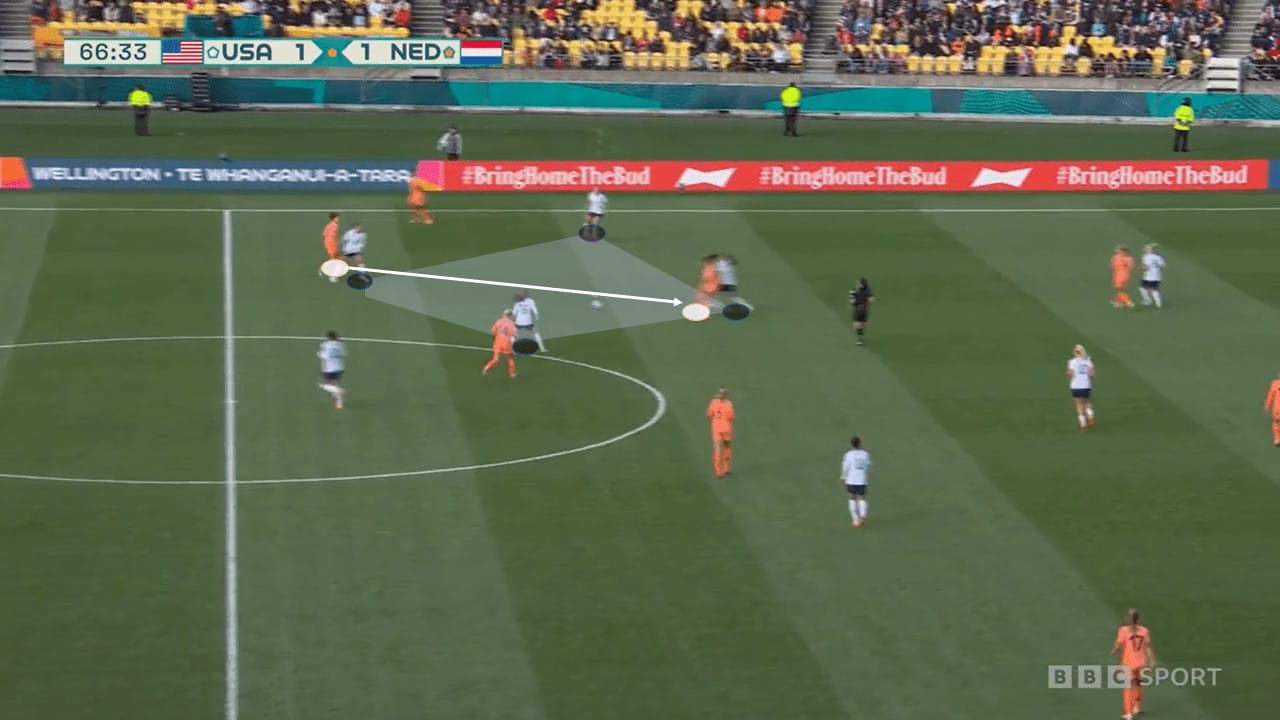
After the equalising goal, the situation leading up to the disallowed goal was as follows: a Netherlands defender passed the ball to her teammate in the half-space. However, the American defensive midfielder reacted swiftly, using their numerical superiority to press and regain possession.
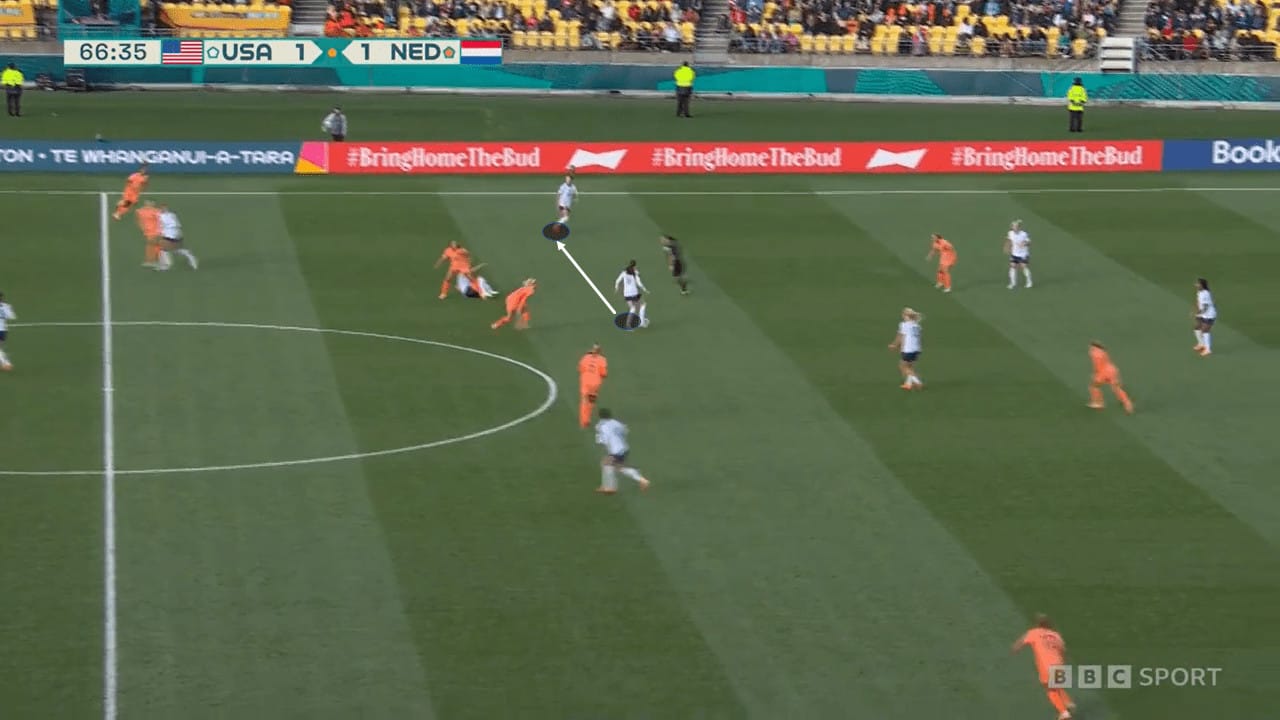
The ball was rapidly played up the field to Trinity Rodman, who skilfully got past the Netherlands defender and quickly delivered a pass to Alex Morgan, who had made a well-timed run into the space. Morgan managed to score on the play, but the goal was unfortunately disallowed due to an offside call.
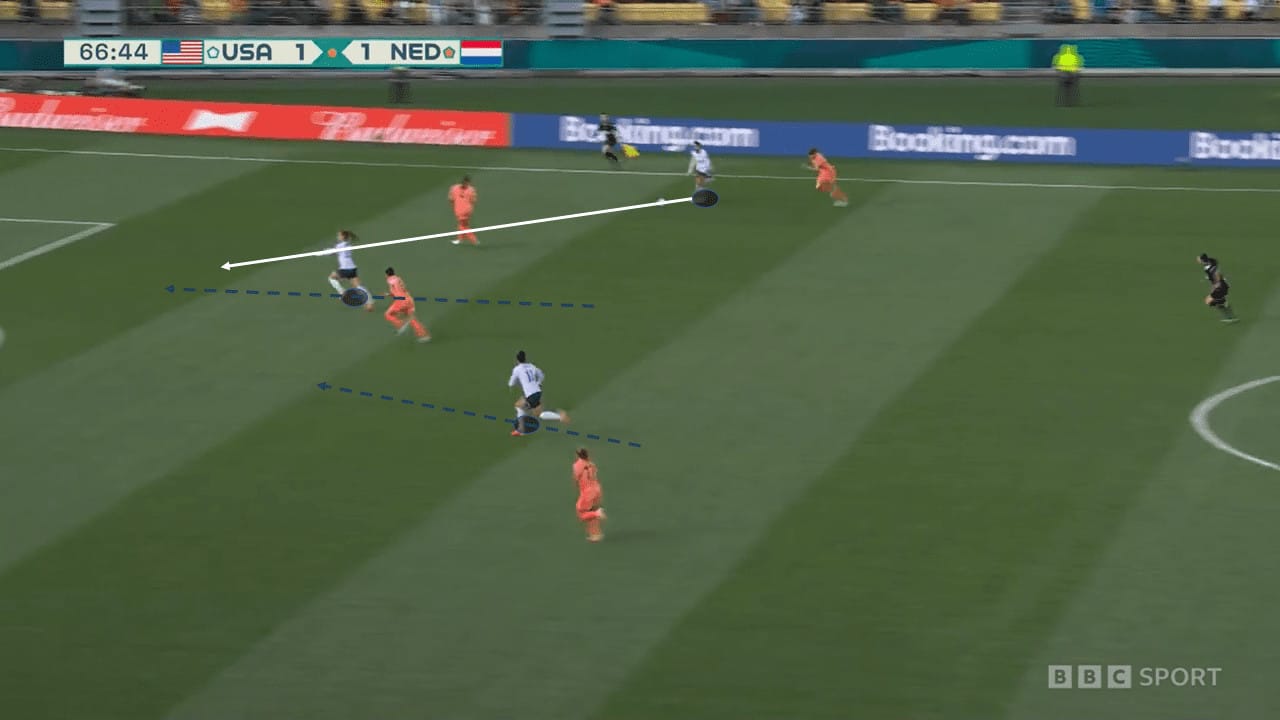
Dismarking at corners
During the first half of the match, USA delivered outswinging corners from the right side, aiming to target space in the centre in front of the goalkeeper or towards the far post.
Notably, Crystal Dunn, moments before playing the corner, was making a deceptive movement intended to draw one of the opponents towards her or cause confusion.
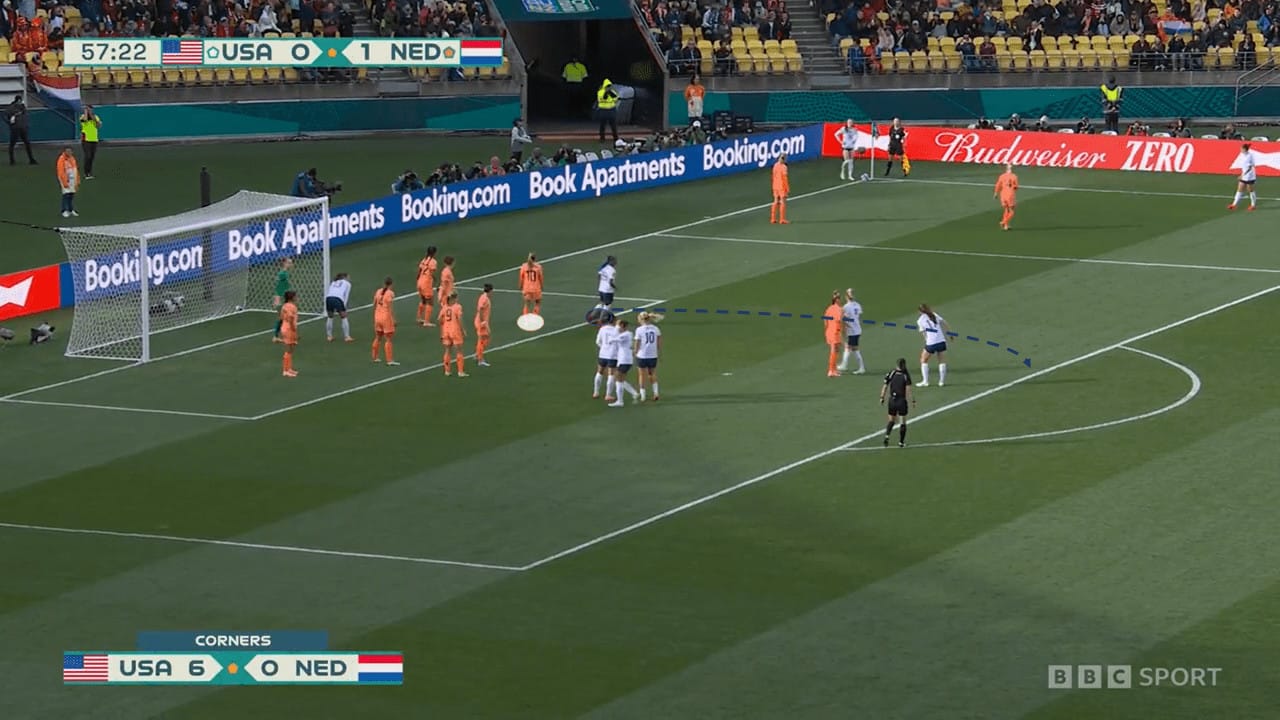
In the second half of the match, the USA made a brilliant tactical adjustment that proved to be crucial in producing a goal. After consistently taking corners with an outswing during the first half, they decided to change in the second half, opting for an inswing delivery. Crystal Dunn continued with her deceptive attitude, making a fake run in the 57th minute that didn’t draw any opponent away.
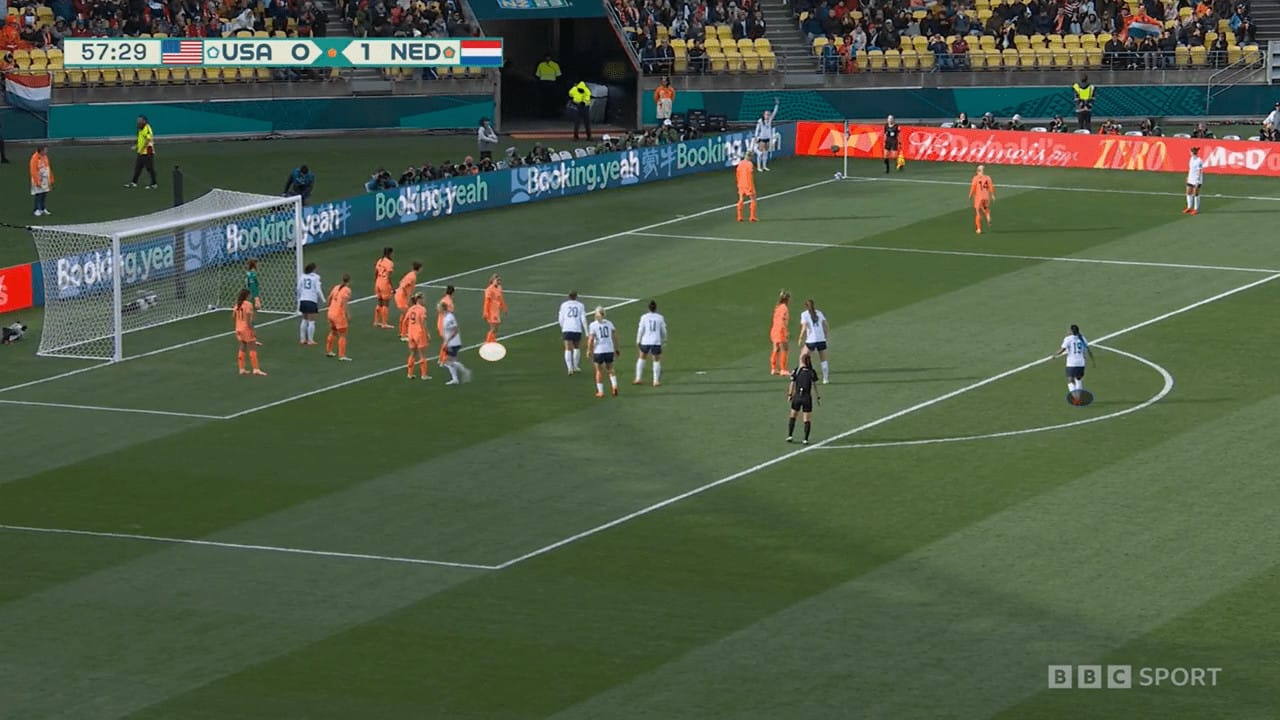
However, the decisive moment came during the goalscoring scene.
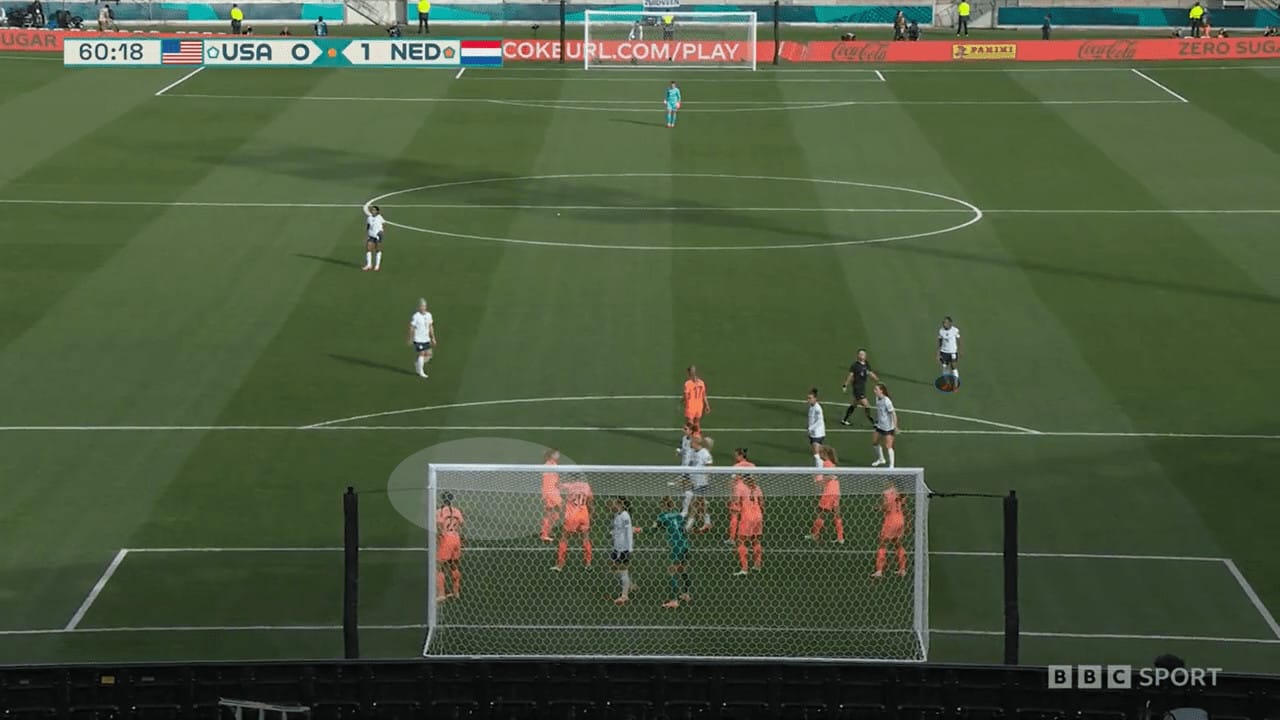
Image credit: BBC SportWith the inswinging corner, Dunn managed to withdraw Netherlands’ player, creating more space at the near post to exploit.
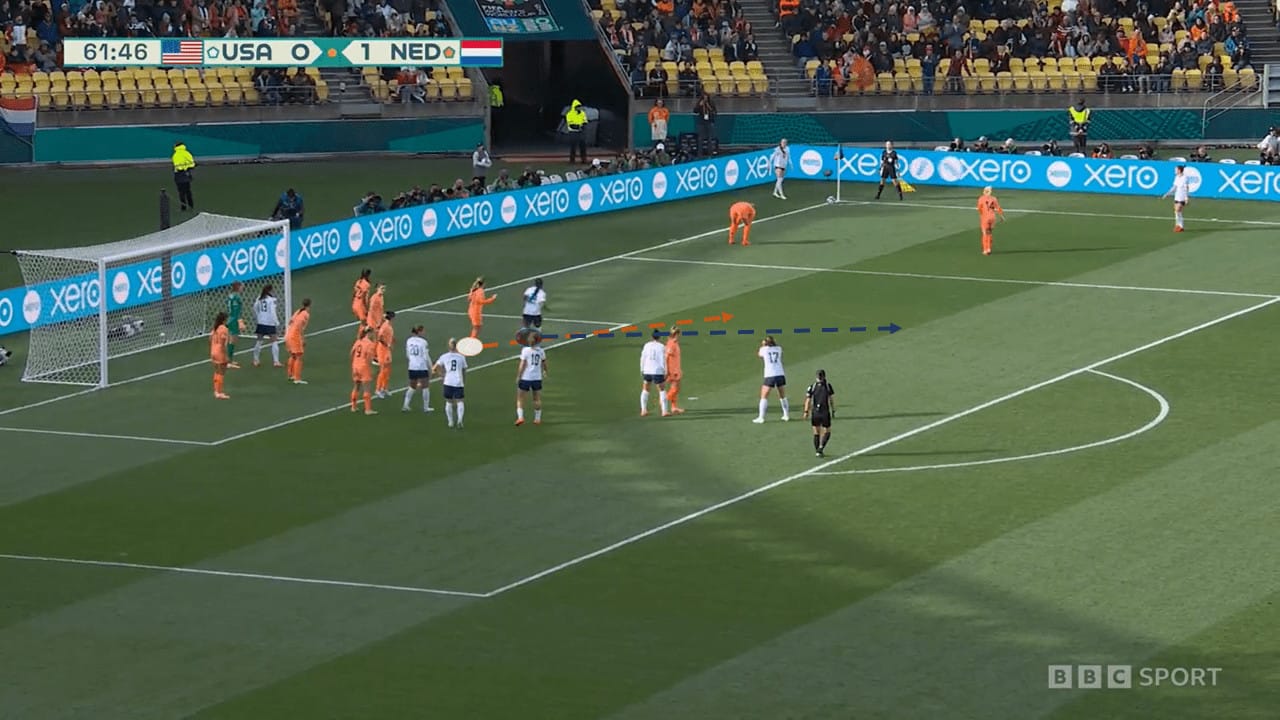
Lindsey Horan received the ball from the corner and skillfully scored with a header.

Conclusion
Indeed, the USWNT analysis highlights the intensity and competitiveness of the match between the USA and the Netherlands, two top teams in women’s football.
To avoid any problematic scenarios, the Americans will have to win the last match to qualify as leaders.
On the other hand, the Netherlands exhibited a formidable version of their team, displaying strength and potential that bodes well for their journey in the tournament.





Comments